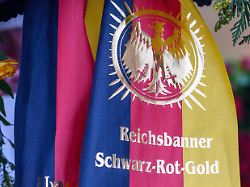Reichsbanner celebrates 100 years
With black, red and gold against the AfD?
February 22, 2024, 7:26 p.m
Listen to article
This audio version was artificially generated. More info | Send feedback
Left-leaning Germans in particular have difficulty with their national colors. The AfD could use this blank space for its “label fraud,” says the chairman of the Reichsbanner Alliance. He demands: dare to have more black, red and gold.
On the 100th anniversary of the founding of the Black-Red-Gold Reichsbanner, the alliance called for greater public use of the German flag. Freedom and democracy need symbols, said chairman Fritz Felgentreu of the SPD in Magdeburg. He would like to see the colors black, red and gold more often in the current demonstrations against the right. “Because these are traditionally the colors of freedom and democracy.”
Felgentreu said that large parts of the political left had a divided relationship with national symbols and would like to emancipate themselves from them. This created a vacuum “into which a party like the AfD pushes and tries to take control of these colors.” This is a “blatant label fraud”. Black, red and gold stand for defensive democracy, the colors are the image of the idea of freedom in Germany.
On February 22, 1924, the non-partisan and social democratic Reichsbanner was founded in Magdeburg to protect democracy. Members of the liberal German Democratic Party and the Catholic Center Party were also there. Democrats wanted to counter left- and right-wing extremist coup attempts in the early years of the Weimar Republic with the Reichsbanner.
Reich banner against steel helmets
At that time, so-called military associations were part of the leisure activities of many men. The main opponent of the Reichsbanner in the 1920s was the German national Stahlhelm, which was also founded in Magdeburg after the end of the First World War. However, the Reichsbanner did not set itself up as an armed militia and did not set up any organized weapons depots.
The reality of its members’ lives had a strong influence on the Reichsbanner at the time, said the head of the German Resistance Memorial Center, Johannes Tuchel. There were even Reichsbanner cigarettes and Reichsbanner margarine. According to the German Historical Museum, with over 1.5 million members, it was the largest mass political organization of the Weimar Republic and pursued both civilian and paramilitary goals.
At the beginning of the 1930s, Reichsbanner members increasingly found themselves in sometimes fatal clashes with the National Socialist Sturmabteilung (SA). According to Felgentreu, more than 60 Reichsbanner people were murdered before the democratic constitutional state was abolished. In March 1933 the Reichsbanner was banned by the Nazis. “We cannot currently even estimate the number of Reichsbanner members who died during the Nazi era,” said Tuchel.
“Democracy is never safe”
Since the re-establishment of the Reichsbanner in 1953, the focus has been on political-historical education and remembrance work. The state parliament of Saxony-Anhalt honored the 100th anniversary with a ceremony. “Democracy is never safe,” emphasized Felgentreu. Addressing the AfD, he said: “Keep your hands off the colors of freedom.” He is waiting for the day “when the Federal Constitutional Court puts an end to this party.”
Historian Benjamin Ziemann from the University of Sheffield said in his keynote address that in the face of a populist rejection of democracy in Europe and a new wave of right-wing nationalism and anti-Semitism, it is clear that many of the basic motives that guided the work of the Reichsbanner in the Weimar Republic are still relevant today. He is particularly thinking about constitutional patriotism, the non-partisan and civil society commitment of convinced Democrats, and the active opposition to any chauvinism and anti-Semitism.
Saxony-Anhalt’s state parliament president Gunnar Schellenberger said that today it was time again to commit to democracy. There are worrying developments and tendencies in Germany that we should not support, said Schellenberger. In collaboration with the German Resistance Memorial Center, a stele was inaugurated on Magdeburg Cathedral Square to commemorate the Reich Banner and its founding in Magdeburg.
